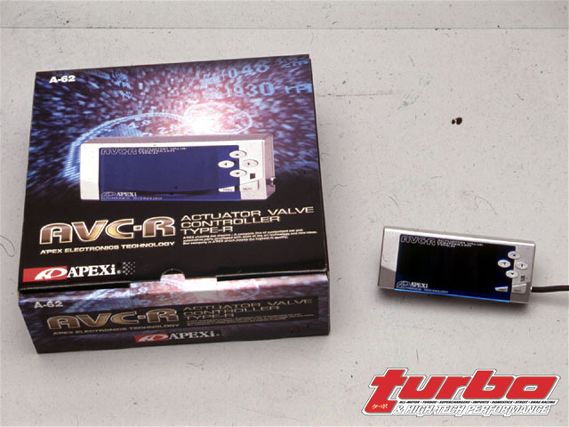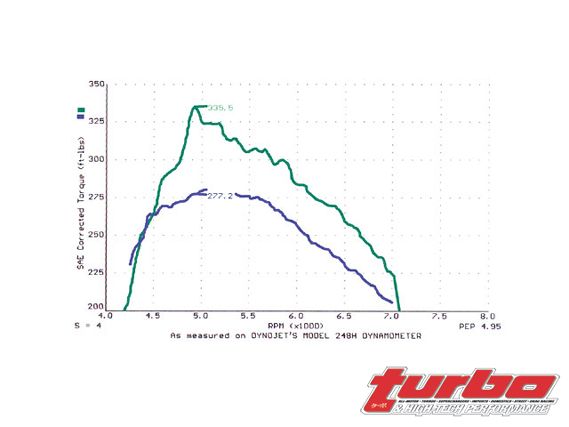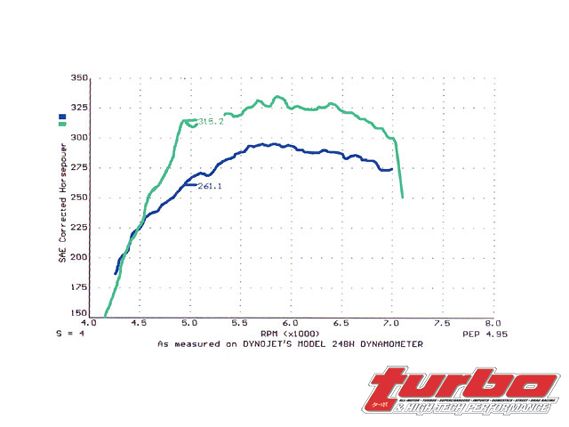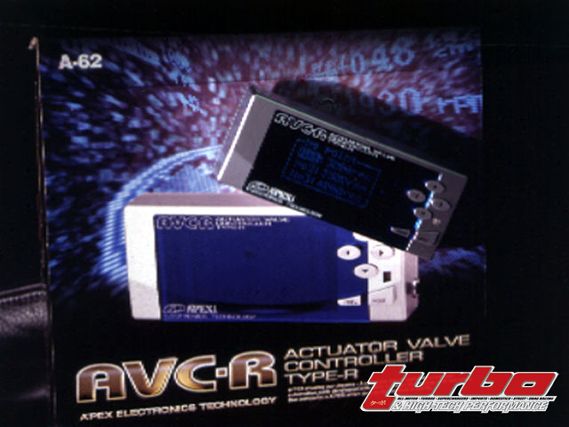 | While in the setting mode the tuner is allowed to change boost and duty settings, scramble boost, tune rpm points for boost pressure and duty cycle and determine feed back speed.
| While in the setting mode the tuner is allowed to change boost and duty settings, scramble boost, tune rpm points for boost pressure and duty cycle and determine feed back speed.
In Part I of Boost it up/Fuel me up, we previewed A'PEXi's new Super AFC and covered the fundamental basics on the importance of a fuel computer. The importance of utilizing a fuel computer with upgraded performance products can not be stressed enough. The majority of factory turbocharged vehicles utilize a hot wire/flap door type of air flow or density metering system. Some vehicles equipped with flow meter type systems are able to compensate and modify the fuel curve when the vehicle is moderately modified with simple bolt ons. However, there is a limitation on how much the factory ECU can alter the preset fuel curve. If the engine is modified beyond the simple bolt-on stage, the factory ECU is not able to compensate for the extra air, resulting in a lean air/fuel mixture. To increase reliability and horsepower a fuel computer should be utilized.
In this installment we will preview A'PEXi's new AVC Type-R boost controller and display dyno-proven horsepower results when used in conjunction with the company's AFC fuel computer. The AVC Type-R is A'PEXi's newest line of boost controllers and supersedes last year's Super AVC-R. The new AVC Type-R hosts a number of new features making the new boost controller second to none. To better understand the purpose of a boost controller and its function we will briefly overview the types of boost controllers available in the market today-manual boost controllers and electronic boost controllers.
 | The boost pressure on the Supra was raised from 0.9 bar to 1.1 bar (3 psi) with the help of the AVC Type -R unit. By fine-tuning the fuel curve with the help of a Motec air/fuel meter the horsepower figure escalated to 334.6 from the baseline of 295.1. An increase of 39.5 peak horsepower from the rather moderate additional boost pressure. The largest improvement came at 4900 rpm where horsepower figure was increased by 54.1.
| The boost pressure on the Supra was raised from 0.9 bar to 1.1 bar (3 psi) with the help of the AVC Type -R unit. By fine-tuning the fuel curve with the help of a Motec air/fuel meter the horsepower figure escalated to 334.6 from the baseline of 295.1. An increase of 39.5 peak horsepower from the rather moderate additional boost pressure. The largest improvement came at 4900 rpm where horsepower figure was increased by 54.1.
Manual Boost Controllers
Most manual boost controllers utilize a regulator valve or relief valve to control boost. When used as an in-line relief valve, some of the manifold pressure is bypassed to the atmosphere preventing the wastegate from opening until higher boost pressure is achieved. By regulating the amount of bypassed air, boost pressure can be raised or lowered. However, boost pressure can't be lowered below the preset actuator spring or wastegate spring setting. When used as a regulator valve the valve controls the amount of manifold pressure that reaches the wastegate/actuator. When run in-line between a pressure source and wastegate/actuator, the regulator valve can prohibit the amount of manifold pressure that reaches the wastegate/actuator. By preventing manifold pressure from reaching the wastegate/actuator, the tuner is able to prevent the opening of the wastegate valve until higher boost pressure is achieved. On external wastegate applications the regulator valve can also be used as a manifold bypass valve. The side-port of the wastegate is T'd to one side of the regulator valve while the other end of the valve is connected to the top-port of the wastegate. The regulator valve can bypass some of the boost pressure to the top-port of the wastegate restricting the opening of the wastegate. By doing so increased boost pressure is achieved.
 | What was even more impressive than the added horsepower was the increase in torque. Peak torque now checks in at 335.6 lbs-ft compared to the 280.4 lbs-ft baseline. The largest increase in torque was also realized at 4900. An increase of 58.3 lbs-ft of torque was registered.
| What was even more impressive than the added horsepower was the increase in torque. Peak torque now checks in at 335.6 lbs-ft compared to the 280.4 lbs-ft baseline. The largest increase in torque was also realized at 4900. An increase of 58.3 lbs-ft of torque was registered.
Although manual boost controllers are often inexpensive to purchase and easy to install there are drawbacks. There are no load, altitude or density corrections and most manual boost controllers lack consistency from gear to gear. More importantly manual boost controllers are known to cause boost spike, which can lead to severe engine damage. Manual boost controllers can also hinder low and mid-range response.
A'PEXi AVC Type-R Electronic Boost Controller
Unlike manual boost controllers that utilize a mechanical regulator/relief valve to control boost, an electronic boost controller utilizes an electronic solenoid valve or in some cases a stepper motor for boost control. The electronic solenoid valve is linked to a microprocessor box that determines how long the solenoid stays open (duty-cycle). The electronic solenoid regulates the amount of air relieved to the atmosphere away from the wastegate or wastegate actuator so higher boost pressure can be realized. With the help of the microprocessor box and information gathered by the pressure sensor the electronic solenoid is commanded to open and close for a specified time to obtain the optimum boost curve. The electronic solenoid can be run in-line for actuator-type wastegate or T'd for external type wastegate. The microprocessor also receives information from an additional pressure sensor to also help determine the duty cycle of the solenoid valve.
Setting Mode
Like many electronic boost controllers A'PEXi AVC Type-R utilizes a microprocessor box, electronic solenoid valve and pressure sensor for boost control. However, unlike other electronic boost controllers the AVC Type-R unit incorporates self-learning mode as well as scramble boost, rpm boost correction and gear based boost control.
 | The monitor mode allows up to four different data channels to be viewed in three different ways-numerical, analog meter and graph display.
| The monitor mode allows up to four different data channels to be viewed in three different ways-numerical, analog meter and graph display.
The AVC Type-R is capable of two preset boost levels-channel A and channel B. For example, one can be used for a low-boost setting ideal for everyday driving and the second channel can be used as a high-boost setting for drag strip duty. Turning off the AVC-R unit deactivates the AVC Type-R's solenoid valve and boost control will be regulated by the wastegate spring or actuator.
In the setting mode the user is allowed to adjust the desired boost pressure and solenoid duty cycle. Both boost and solenoid duty-cycle are adjustable by the tuner at the selected eight-rpm points. The tuner can adjust the eight-RPM points between 1500 and 9500-rpm in 500-rpm increments. By allowing boost and solenoid duty cycle to be adjusted at eight different rpm points the boost curve can be custom tailored by the tuner.
Each preset channel can also incorporates a scramble boost feature. By adding a momentary switch, boost pressure can be increased or decreased for a certain amount of time. The user can also choose to increase or decrease solenoid duty cycle to further control the boost pressure rate. This feature is especially beneficial to traction-limited vehicles.
 | In the main menu the user can choose between channel A or B for two different boost settings.
| In the main menu the user can choose between channel A or B for two different boost settings.
Monitor Mode
The A'PEXi AVC Type-R offers a clever monitoring mode that is often non-existent in other electronic boost controllers. The AVC Type-R monitor mode allows up to four channels to be previewed at one time in three different ways-Numerical, Digital Analog-style Meter and Graph display. The AVC Type-R unit can monitor intake manifold vacuum/boost pressure, engine speed (RPM), vehicle speed, throttle position, solenoid valve duty cycle and injector duty cycle. In both the numeric and digital analog-style meter mode the user can see a peak/hold value for the chosen parameter. The graphic display mode allows the user to record or "sample" data channels. The recorded data can then be replayed and reviewed by the user for crucial tuning information. If only one channel was being viewed up to 60 seconds can be sampled. Two channels offers 30 seconds of recorded play, three channels last 20 seconds and four channels last only 15 seconds.
Besides the monitoring mode in numeric, digital analog-style meter and graph display, the AVC Type-R unit can also monitor in a 2D-trace mode. Up to five parameters can be monitored, but only one at a time-boost, vehicle speed, throttle position, solenoid duty and injector duty. The 2D-trace mode allows one tuner-selected parameter to view versus engine rpm. In the 2D-trace mode there are three ways to view the 2D trace. One way is a simple cursor, second a 10 point floating trail and the third being a "Ghost Map" trace. The Ghost Map shows wherever the cursor has been and does not disappear until the tuner clears the screen.
Dyno Proven
As you may have already noticed our February 2000 issue is dominated by Supras and we felt it was only fitting to dyno test the new A'PEXi AVC Type-R and Super AFC on a twin-turbo Supra. Our tester vehicle is a moderately modified 1996 automatic twin-turbo Supra equipped with an A'PEXi N1 exhaust, K&N air filter element and HKS Fuel Cut Defenser (FCD). With the addition of the air filter and exhaust system still incorporating the factory catalytics the Toyota's power output was raised to 295.1 horsepower and 280.4 lbs-ft of torque. This figure will be used as our baseline. The AVC Type-R comes with all the necessary hardware and instructions for a straightforward installation. Only a qualified technician should install the Super AFC and AVC Type-R. Improper installation of the units can lead to possible electronic problems and engine failure. First to be adjusted on the Supra was the AVC Type-R unit; the factory boost pressure of 0.9 bar (13.23 psi) was raised to 1.1 bar (16.17 psi). With the help of a Motec air/fuel meter the fuel curve was fine-tuned with the A'PEXi Super AFC for optimum reliability and horsepower. The power duo enabled the Supra to pound the rollers of the Dynojet to a tune of 334.6 horsepower and 335.6 lbs-ft of torque. The Toyota made the largest improvement at 4900 rpm where horsepower jumped up by 54.1 and torque figures escalated to 58.3 lbs-ft. It should be noted that most of the power gains were realized from fine tuning the fuel curve. Nearly 30 horsepower and 30 lbs-ft torque were realized from just tuning the air/fuel mixture.
When it comes to modifying your vehicle everyone is looking for the best bang for the buck. If you are going to spend a $1000 dollars you would expect some noticeable performance gains to by realize. There are not many performance products in the market the offers the kind of horsepower gains per dollar spent like the A'PEXi power duo. The A'PEXi units offer amazing tuneability and monitoring capabilities all in one compact package. With the addition of the A'PEXi Super AFC and AVC Type-R you get added performance and reliability without burning a hole in your bank account.
